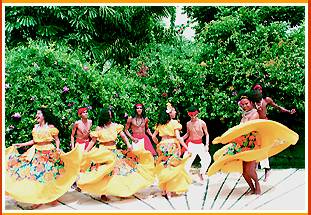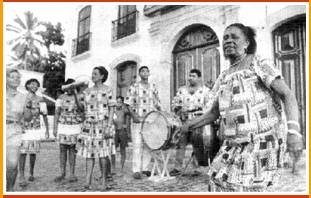
OUR
RHYTHMS, OUR COLLECTIVE IMAGINATION

THE
BACNARÉ GROUP. Photo: Hans von Manteuffel |
 |
The influence of the Brazilian
natives, the Africans and the Europeans, has provoked an
extremely unique
cultural identity in the Northeast. An identity that is revealed in its multiplicity
of rhythms and artistic manifestations. It shows the face of our
people who, in their everlasting fight for a dignified life, are
eternally open to the day-to-day blossoming of happiness. |
When
you watch people of all ages accompanying and singing together with Dona Selma's
Coco, it is quite apparent how enjoyment, dance and
music (with its
playful, contagious verses), are so important for the people of the
Northeast. Today, this great conquest is clearly represented by the coco -
the coconut dance - an ancient rhythm that has been retrieved and firmly
planted in the Northeast.
Within
the beauty of its dance and the strength of its verses, many folkloric
experts have created definitions regarding coco. The majority agree
that it was originally a work song of the coconut pickers, and that only
sometime after, it was transformed into a dance rhythm. Some affirm that it
first made its humble appearance in the rural areas, on the sugar plantations, and later
spread to the coastal
regions, after which, it made its way to the more refined environments. Others, on the other hand, believe that it
is essentially a dance of the beach, because of the predominance of
coconut palms found in this region. In relation to which state of the
Northeast the dance actually appeared first, the disagreements are even greater and more diverse.
References to the three states of Alagoas,
Paraíba and Pernambuco are found in the existing texts, indicating them
all to be
the probable "owners" of this dance. So, where is its
real origin? This is a vacuum to be filled by those who are
curious, interested and have the spirit to discover. In the middle of so
many doubts,
one thing is certain: the coco has its origins in the people - the
masses. With regard to its
form of expression, the researchers define many 'types of coco'. It would
not be a trustworthy notion to be content with just one classification, before such
an adversity
of definitions. What we have noticed is that the variations of coco
begin with
the differing names given from one region to another. These variations can be
identified in aspects of the dance itself, and mainly in the metric differences of the
sung verses. Overall however, the coco is presented in one basic form: the
participants form lines or circles in which they carry out a characteristic
type of 'tap dance', react to the chorus, and clap their hands to the rhythm. It is
also very common to find a leading singer, and it is from the moment that
this person begins to sing, either improvising or or with traditionally
known songs, that the festivities begin.
"Coqueiro, tá de coco novo
minha gente o que é que há..."
("Hey! Everybody! The
coconut tree is full of coconuts - is there anything wrong with
that........?)
The coco can be danced with or
without shoes. Also, it does not have its own appropriate costume. In order to participate,
the people can use any kind of clothing. There is also, apparently, no special time of the year
to dance, although it is
more often seen in June. Musically speaking, there is a predominance of
percussion instruments. According to folklore researchers, the most
commonly used instruments are - ganzás (a kind of maraca), bombos
(drums), zabumbas (a deeper drum), caracaxás (a kind of scraped rattle,
often made of undulated metal and scraped with a small stick to produce
the sound) and cuícas (a drum -like instrument that
makes a squeaking sound).
However, to form a circle of coco it is not necessary to have all, or
indeed any of these
instruments. Very often, the dance takes place with just the clapping of
the participants' hands.
Within its general characteristics it is possible to notice one
distinct distinguishing feature - community spirit. There is always a very happy atmosphere where men, women, children
of all social classes sing and dance together without distinction. In what
is referred to as its ethnic influences, the African influence is most prevalent,
mainly in its rhythm, and most certainly in its movements. But, there is also a
very strong native contribution to the choreography. Both the circle and
the lines are aspects that were inherited from our natives.

DONA
SELMA'S
COCO. Photo: Eduardo Queiroga |
 |
Today the
coco is ever present in the festivities of our people. Selma and
many other traditional conquests are examples of the resistance and
strength of an authentic and original manifestation. This contagious
rhythm has influenced numerous popular composers through the ages, and even
contemporary Pernambuco music . The famous Jackson do Pandeiro influenced Chico
Science, Alceu Valença and many other local musicians who have
consistently searched for this playful aspect in the creation of
their work. |

|